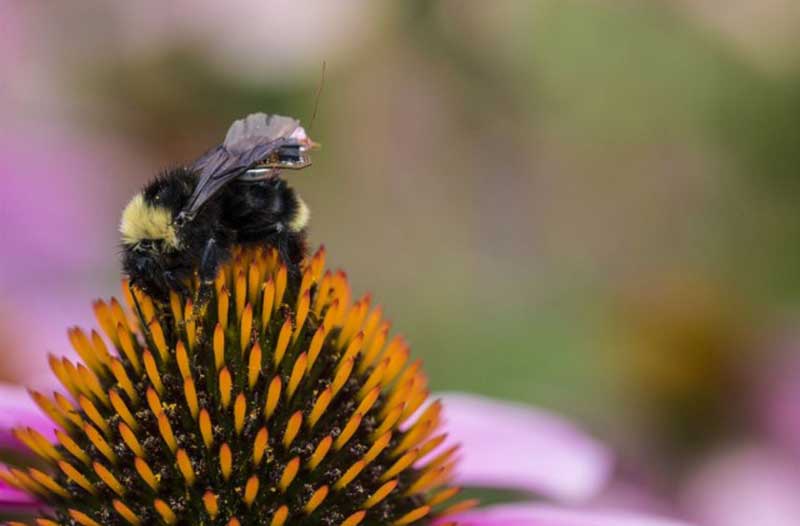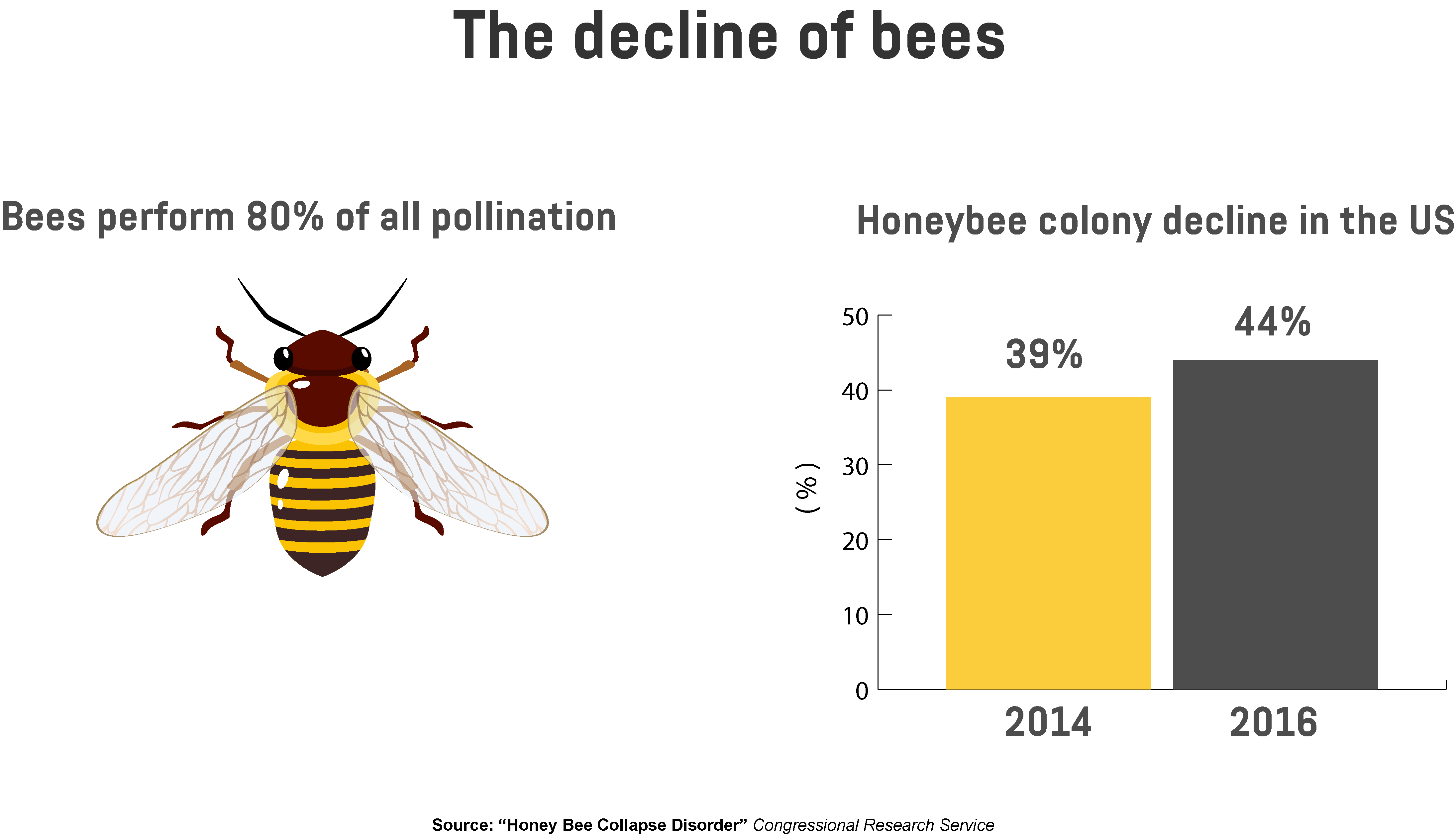- High-tech bumblebees could potentially serve farmers better than drones
- The decline in the bee population threatens crop production
- Genetically modified cyborg dragonflies
- Uber-futuristic cyborg insects will enhance our understanding of nature and help bees with pollination
Due to our expanding population, global food demand is increasing, and there are concerns that traditional agriculture won’t be able to meet this growing demand. To produce more food with less resources and with lower costs, farmers are starting to explore smart agriculture practices. Not only does technology help them achieve greater productivity, but it also makes them more resilient to risks, which is why farmers’ reliance on these tools will become even greater in the future.

In fact, the research firm MarketsandMarkets reports that the smart agriculture market was worth $7.53 billion in 2018, and it’s expected to reach a value of $13.5 billion by 2023. Specialised equipment, IT services, and software allow farmers to identify and monitor different field conditions, including weather, soil quality, and crop conditions.Based on this real-time field data, farmers can make sure their crops are getting exactly what they need to reach optimum growth and productivity.
One of the technologies that’s become very popular among farmers is drones equipped with GPS and built-in cameras that help them with dull and time-consuming tasks. For instance, when done manually, field mapping and pesticide spraying takes a lot of time and is labour-intensive. With the help of drones, farmers can complete these tasks much faster. However, even though drones offer a wide range of applications for smart farming, they still rely on batteries, which reduces their usefulness. So, farmers need something even more efficient. The solution is hidden in nature’s tireless flying machines – insects.
High-tech bumblebees could potentially serve farmers better than drones
Bees have played a key role in pollination for millenia, and it’s not an understatement to say that our agricultural system heavily depends on them. Now, with recent breakthroughs, they could do even more. At the end of 2018, a team of researchers from the University of Washington (UW) announced that they’ve developed a small sensor-embedded package designed to be worn on a bumblebee’s back. The package features battery technology that weighs around 70 milligrams, while the entire backpack weighs only 102 milligrams, equivalent to the weight of seven grains of rice. Though it’s tiny, this battery will last up to seven hours of flight, and when the bee returns to its hive at night, the battery will recharge itself wirelessly. This is a much better alternative to drones, which can usually fly for up to 20 minutes before needing a recharge. According to the lead author of the study, Vikram Iyer, this technology “is a great way to complement what drones can do for agriculture.” As he explains, while unmanned aerial vehicles do a good job when it comes to flying at high altitudes, “bees can go up to individual plants, and also give us insights into things like pollination”.

To attach this electronic ‘backpack’ on a bee, the scientists first used a jar to catch the bee coming out of the hive. Then they cooled down the jar in the fridge for two or three minutes to make the bee silent and less active, which made it easier for the researchers to attach the package onto its back. The innovation has already been tested on a soccer field, where they placed a base station equipped with four antennas. As they moved the jar with the bee inside further away, the bee’s position was detected within 80 metres from the antennas. The team also added sensors to the backpack to monitor temperature, humidity, and light intensity in the field. The only issue is that the sensor is able to store only 30 kilobytes of data due to its size, which is significantly less than the amount of data collected by a traditional drone.
The scientists are also planning to create a backpack equipped with cameras, so their bionic bees could eventually stream information to farmers in real time and allow them to check crop health whenever the bees are out in the field. The system, which costs only a few dollars to make, is completely safe for the bee. Since bees can carry payloads close to their weight (bear in mind that a single bee weighs around 113 milligrams on average), UW’s backpack is light enough for the the bee to carry it and not be affected by it. Though the team proved their concept works, they still need to find ways to commercialise it.
The decline in the bee population threatens crop production
UW’s innovation is important because bees are one of the world’s most important pollinators. In fact, they perform 80 per cent of all pollination. Unfortunately, bee habitats are shrinking every year. Statistics show that in the US alone, honeybee keepers lost 39 per cent of their colonies in 2014, which grew to 44 per cent in 2016. Unfortunately, this trend shows no sign of stopping. And while the decline in bee colonies is evident, the demand for pollination from fruit and vegetable growers is rising.

The decline of bees has also had a direct impact on the dairy and beef industry, because bees pollinate hay and clover, which are used to feed livestock. This leads to higher cost of feedstock, which automatically makes dairy and beef products more expensive in grocery stores.
The reason for bees’ increased mortality is no mystery. It’s mostly driven by factors such as climate change, parasites, and wider use of insecticides and pesticides. In 2018, researchers from the University of Texas discovered that glyphosate, a very common pesticide used to control weeds, can weaken the bee’s immune system and make it more vulnerable to infections and parasites. Bees usually pick up residues of this pesticide from nectar or pollen and bring it to their hive, which then exposes the entire colony to this harmful substance. Moreover, an insecticide called neonicotinoid, which is similar to nicotine, poses a danger to both bees and humans. These pesticides are found in half of North American honey. Neonicotinoids can lead to nervous system disorders such as autism spectrum disorders and memory loss. For this reason, the European Union has already voted to ban the use of neonicotinoids on farms and in gardens.
With bees in decline, researchers are exploring ways to equip other insects with navigation technology and sensors to turn them into living drones and pollinators.
Genetically modified cyborg dragonflies
That’s one of the reasons why Draper Laboratory, a research and development organisation, and the Howard Hughes Medical Institute (HHMI) joined forces to launch the DragonflEye project. The goal was to create a technology that will allow scientists to control the flight of insects. Though the project was conducted on a dragonfly, the team believes the same tech could also be used on bees, as well as other smaller insects. DragonflEye is based on a cybernetic approach that uses real insects, in this case dragonflies, and equips them with cutting-edge electronics to control their movement.
Similar to the work of UW’s scientists, the group working on DragonflEye created a small ‘backpack’ designed to send navigation commands directly into the dragonfly’s nervous system. The insect was previously genetically modified to accept those commands. Here’s how it works. Thanks to a tweaked gene that makes the dragonfly’s steering neurons sensitive to light, the scientists used optical structures, called optrodes, to send light pulses to those neurons. In other words, this allows them to directly control the insect’s movement. The system, powered by a tiny solar panel, “pushes the boundaries of energy harvesting, motion sensing, algorithms, miniaturization and optogenetics, all in a system small enough for an insect to wear”, says Draper Lab’s engineer, Jesse Wheeler. Though the science behind the concept is sound, so far, the team only managed to make the dragonfly fly in a straight line, which means it still needs a lot of improvement. In the future, they plan to reduce the size of the backpack and make it suitable for smaller insects as well, including bees.
Uber-futuristic cyborg insects will enhance our understanding of nature and help bees with pollination
Just like any other technology today, traditional robotic drones come with limitations. But cyborg insects, as scientists propose, could become powerful smart farming tools. These cyborgs could fly almost anywhere, and we wouldn’t need to power them every 20 minutes, like a regular drone. While some might consider this the ultimate spying tool, using real insects and equipping them with sensor networks and autonomous navigation technology could help with pollination. Since the number of bee colonies is decreasing, farmers could easily equip other insects and use them as pollinators. What’s more bees and other insects carrying sensors and navigation technology could allow researchers to better understand insect behaviour and get a glimpse into what they’re seeing and feeling. This would also allow us to easily collect data in remote and obscure places to get a detailed understanding of nature.
Share via:


